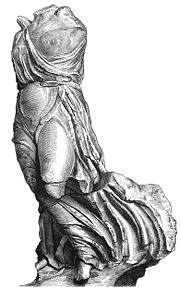
Paeonius
Encyclopedia

Mende (Greece)
Mende was an ancient Greek city located in the western coast of Pallene peninsula in Chalkidiki facing the coast of Pieria across the narrow Thermaic Gulf near the modern town of Kalandra.- Ancient History :...
in Macedonia
Macedonia (Greece)
Macedonia is a geographical and historical region of Greece in Southern Europe. Macedonia is the largest and second most populous Greek region...
was a Greek sculptor of the late 5th century BC. The only work that can be definitely attributed to him is the statue of Nike (circa 420 BC) discovered at Olympia
Olympia, Greece
Olympia , a sanctuary of ancient Greece in Elis, is known for having been the site of the Olympic Games in classical times, comparable in importance to the Pythian Games held in Delphi. Both games were held every Olympiad , the Olympic Games dating back possibly further than 776 BC...
. According to the inscription on the base, it was dedicated by the people of Messenia
Messenia
Messenia is a regional unit in the southwestern part of the Peloponnese region, one of 13 regions into which Greece has been divided by the Kallikratis plan, implemented 1 January 2011...
and Naupactus
Naupactus
Naupactus or Nafpaktos , is a town and a former municipality in Aetolia-Acarnania, West Greece, Greece. Since the 2011 local government reform it is part of the municipality Nafpaktia, of which it is the seat and a municipal unit...
after a victory in an unnamed conflict, possibly the battle of Sphacteria
Battle of Sphacteria
The Battle of Sphacteria was a land battle of the Peloponnesian War, fought in 425 BC between Athens and Sparta. Following the Battle of Pylos and subsequent peace negotiations, which failed, a number of Spartans were stranded on the island of Sphacteria...
.
Paeonius also won the commission to decorate the acroteria
Acroterion
An acroterion or acroterium is an architectural ornament placed on a flat base called the acroter or plinth, and mounted at the apex of the pediment of a building in the Classical style. It may also be placed at the outer angles of the pediment; such acroteria are referred to as acroteria angularia...
of the Temple of Zeus
Zeus
In the ancient Greek religion, Zeus was the "Father of Gods and men" who ruled the Olympians of Mount Olympus as a father ruled the family. He was the god of sky and thunder in Greek mythology. His Roman counterpart is Jupiter and his Etruscan counterpart is Tinia.Zeus was the child of Cronus...
at Olympia (about 430 - 420 BC), Pausanias
Pausanias (geographer)
Pausanias was a Greek traveler and geographer of the 2nd century AD, who lived in the times of Hadrian, Antoninus Pius and Marcus Aurelius. He is famous for his Description of Greece , a lengthy work that describes ancient Greece from firsthand observations, and is a crucial link between classical...
was probably wrong in claiming that he worked on the sculptures for the pediment
Pediment
A pediment is a classical architectural element consisting of the triangular section found above the horizontal structure , typically supported by columns. The gable end of the pediment is surrounded by the cornice moulding...
s of the temple.
The Nike of Paeonius featured as part of the design of the medals of the 2004 Summer Olympics
2004 Summer Olympics
The 2004 Summer Olympic Games, officially known as the Games of the XXVIII Olympiad, was a premier international multi-sport event held in Athens, Greece from August 13 to August 29, 2004 with the motto Welcome Home. 10,625 athletes competed, some 600 more than expected, accompanied by 5,501 team...
in Athens
Athens
Athens , is the capital and largest city of Greece. Athens dominates the Attica region and is one of the world's oldest cities, as its recorded history spans around 3,400 years. Classical Athens was a powerful city-state...
and is now exhibited at the Archaeological Museum of Olympia.

